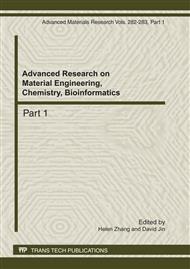p.514
p.518
p.522
p.526
p.531
p.535
p.539
p.545
p.549
Growth Rate Model and Temperature-Changing Fermentation Process of Pseudomonas Syringae Pv. Mori M4-13
Abstract:
Pseudomonas syringae pv. mori M4-13 is a new coronatine-production strain isolated from mulberry trees. As a high efficient plant growth substance, coronatine is difficult to obtain from the traditional bacteria under the high temperature. The fermentation temperature cannot be greater than 301K. However, the coronatine production is strictly growth associated. Therefore, biomass growth and accumulation of coronatine should be studied coordinately. In this paper, the growth rate of the strain was studied by the square root model, and the temperature-changing fermentation pattern of coronatine was optimized. In the fitting function of , the value of b was 0.03276, c was 0.1759, R2= 0.99. Based on the results, the optimal growth temperature of Pseudomonas syringae pv. mori M4-13 is 305K. The accumulation of coronatine reaches the peak, when the strain was incubated at the 305K for 3 days, following with the fermentation at 291K for another 3days. This fermentation pattern lay a solid foundation for the large-scale applications in the industrial production.
Info:
Periodical:
Pages:
531-534
Citation:
Online since:
July 2011
Authors:
Price:
Сopyright:
© 2011 Trans Tech Publications Ltd. All Rights Reserved
Share:
Citation:


